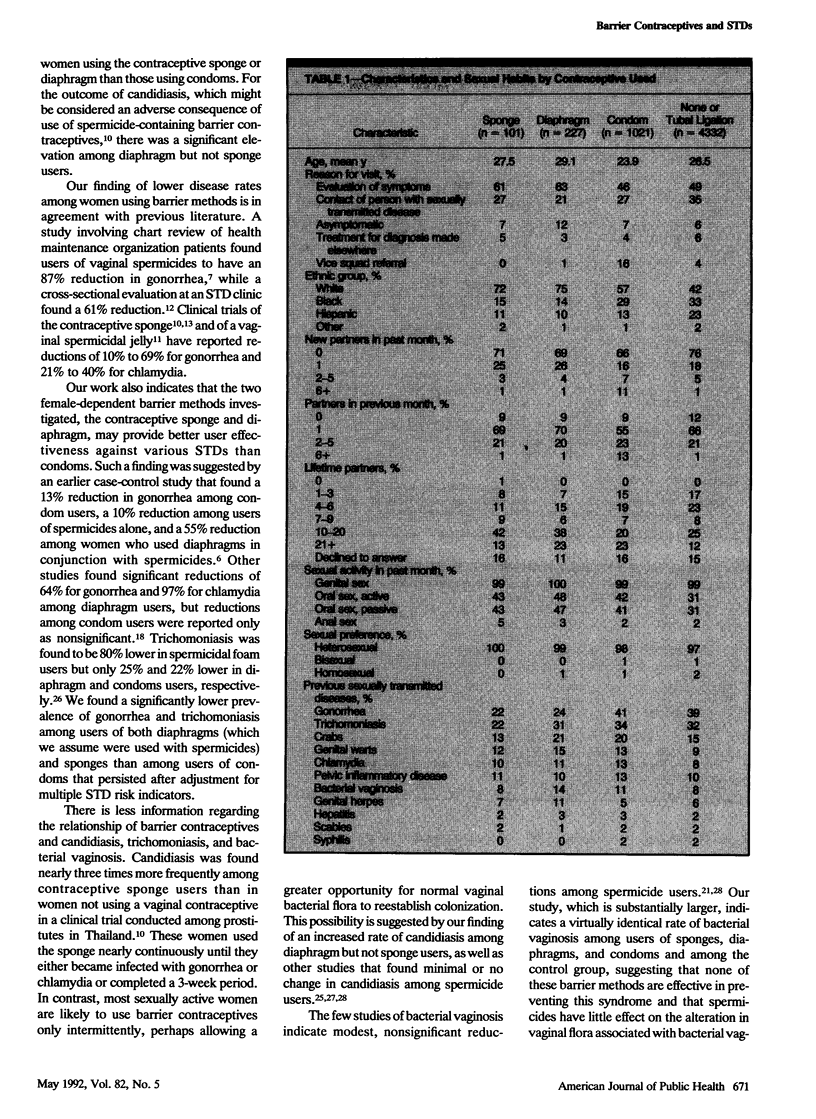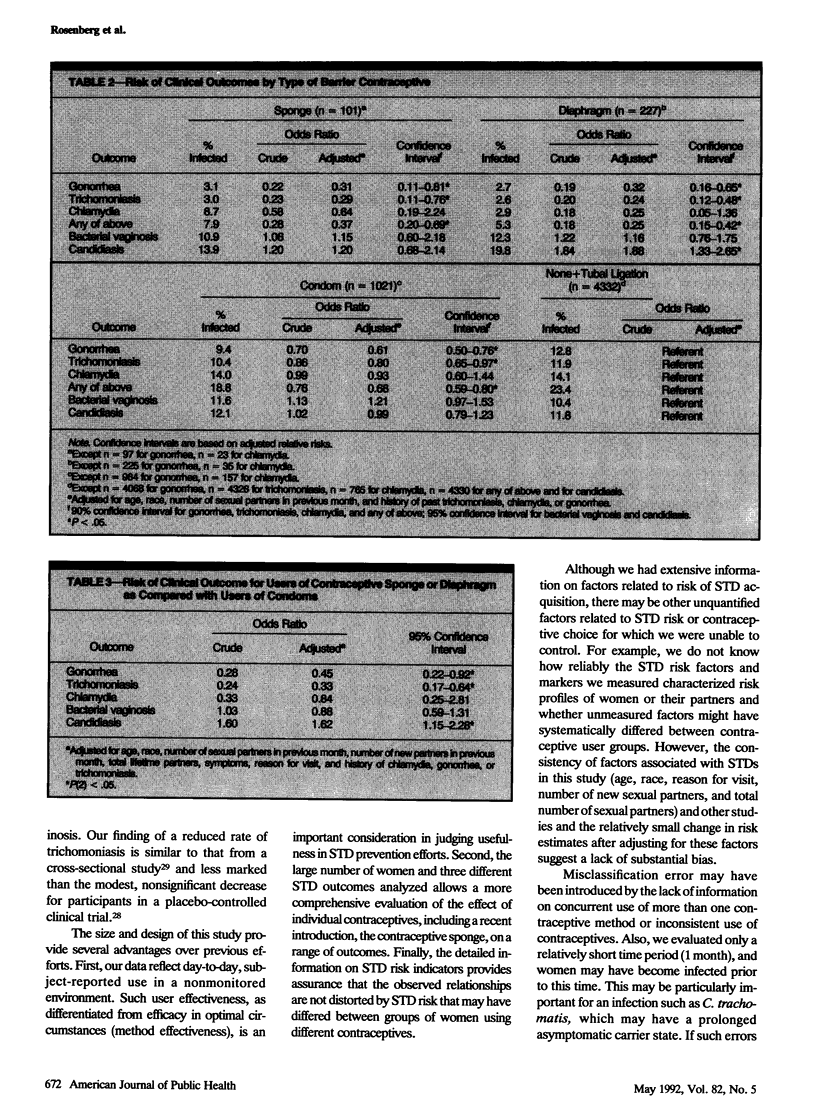Abstract
INTRODUCTION. Most efforts at sexually transmitted disease (STD) protection center on condom use, but little is known about how condoms compare with other barrier methods, particularly those controlled by women. METHODS. To evaluate the effect of different barrier contraceptives on the prevalence of STDs and other vaginal infections, we retrospectively studied 5681 visits by women to an urban STD clinic. RESULTS. As compared with women using no contraceptive or with tubal ligations, women using the contraceptive sponge or diaphragm had at least 65% lower rates of infection with Neisseria gonorrhoeae and Trichomonas vaginalis, while condom users had 34% and 30% lower rates, respectively. For Chlamydia trachomatis, the reduction was 13% among sponge users, 72% among diaphragm users, and 3% among condom users, although these differences were not significant. When compared with women using condoms, women using female-dependent methods (sponge or diaphragm) had significantly lower rates of both gonorrhea and trichomoniasis. Vaginal candidiasis was more common among women using diaphragms but not other barrier methods, while rates of bacterial vaginosis were similar among all groups. CONCLUSIONS. Women using the contraceptive sponge or diaphragm experience protection from STDs to a greater extent than those relying on condoms. Female-dependent barrier contraceptives should receive more attention in STD risk-reduction programs.
Full text
PDF





Selected References
These references are in PubMed. This may not be the complete list of references from this article.
- Amsel R., Totten P. A., Spiegel C. A., Chen K. C., Eschenbach D., Holmes K. K. Nonspecific vaginitis. Diagnostic criteria and microbial and epidemiologic associations. Am J Med. 1983 Jan;74(1):14–22. doi: 10.1016/0002-9343(83)91112-9. [DOI] [PubMed] [Google Scholar]
- Austin H., Louv W. C., Alexander W. J. A case-control study of spermicides and gonorrhea. JAMA. 1984 Jun 1;251(21):2822–2824. [PubMed] [Google Scholar]
- Barbone F., Austin H., Louv W. C., Alexander W. J. A follow-up study of methods of contraception, sexual activity, and rates of trichomoniasis, candidiasis, and bacterial vaginosis. Am J Obstet Gynecol. 1990 Aug;163(2):510–514. doi: 10.1016/0002-9378(90)91186-g. [DOI] [PubMed] [Google Scholar]
- Barlow D. The condom and gonorrhoea. Lancet. 1977 Oct 15;2(8042):811–813. doi: 10.1016/s0140-6736(77)90737-1. [DOI] [PubMed] [Google Scholar]
- Bradbeer C. S., Thin R. N., Tan T., Thirumoorthy T. Prophylaxis against infection in Singaporean prostitutes. Genitourin Med. 1988 Feb;64(1):52–53. doi: 10.1136/sti.64.1.52. [DOI] [PMC free article] [PubMed] [Google Scholar]
- Darrow W. W. Condom use and use-effectiveness in high-risk populations. Sex Transm Dis. 1989 Jul-Sep;16(3):157–160. doi: 10.1097/00007435-198907000-00008. [DOI] [PubMed] [Google Scholar]
- Ehret J. M., Judson F. N. Genital Chlamydia infections. Clin Lab Med. 1989 Sep;9(3):481–500. [PubMed] [Google Scholar]
- Feldblum P. J., Bernardik E., Rosenberg M. J. Spermicide use and sexually transmitted disease. JAMA. 1988 May 20;259(19):2851–2851. doi: 10.1001/jama.1988.03720190023022. [DOI] [PubMed] [Google Scholar]
- Fischl M. A., Dickinson G. M., Scott G. B., Klimas N., Fletcher M. A., Parks W. Evaluation of heterosexual partners, children, and household contacts of adults with AIDS. JAMA. 1987 Feb 6;257(5):640–644. [PubMed] [Google Scholar]
- Hicks D. R., Martin L. S., Getchell J. P., Heath J. L., Francis D. P., McDougal J. S., Curran J. W., Voeller B. Inactivation of HTLV-III/LAV-infected cultures of normal human lymphocytes by nonoxynol-9 in vitro. Lancet. 1985 Dec 21;2(8469-70):1422–1423. doi: 10.1016/s0140-6736(85)92584-x. [DOI] [PubMed] [Google Scholar]
- Hooper R. R., Reynolds G. H., Jones O. G., Zaidi A., Wiesner P. J., Latimer K. P., Lester A., Campbell A. F., Harrison W. O., Karney W. W. Cohort study of venereal disease. I: the risk of gonorrhea transmission from infected women to men. Am J Epidemiol. 1978 Aug;108(2):136–144. doi: 10.1093/oxfordjournals.aje.a112597. [DOI] [PubMed] [Google Scholar]
- Jick H., Hannan M. T., Stergachis A., Heidrich F., Perera D. R., Rothman K. J. Vaginal spermicides and gonorrhea. JAMA. 1982 Oct 1;248(13):1619–1621. [PubMed] [Google Scholar]
- Lawrence D. N., Jason J. M., Holman R. C., Heine P., Evatt B. L. Sex practice correlates of human immunodeficiency virus transmission and acquired immunodeficiency syndrome incidence in heterosexual partners and offspring of U.S. hemophilic men. Am J Hematol. 1989 Feb;30(2):68–76. doi: 10.1002/ajh.2830300204. [DOI] [PubMed] [Google Scholar]
- Lazar A. Trichomonas vaginalis infection. Incidence with use of various contraceptive methods. J Med Soc N J. 1970 May;67(5):225–226. [PubMed] [Google Scholar]
- Louv W. C., Austin H., Alexander W. J., Stagno S., Cheeks J. A clinical trial of nonoxynol-9 for preventing gonococcal and chlamydial infections. J Infect Dis. 1988 Sep;158(3):518–523. doi: 10.1093/infdis/158.3.518. [DOI] [PubMed] [Google Scholar]
- Magder L. S., Harrison H. R., Ehret J. M., Anderson T. S., Judson F. N. Factors related to genital Chlamydia trachomatis and its diagnosis by culture in a sexually transmitted disease clinic. Am J Epidemiol. 1988 Aug;128(2):298–308. doi: 10.1093/oxfordjournals.aje.a114970. [DOI] [PubMed] [Google Scholar]
- Mann J., Quinn T. C., Piot P., Bosenge N., Nzilambi N., Kalala M., Francis H., Colebunders R. L., Byers R., Azila P. K. Condom use and HIV infection among prostitutes in Zaire. N Engl J Med. 1987 Feb 5;316(6):345–345. doi: 10.1056/NEJM198702053160616. [DOI] [PubMed] [Google Scholar]
- Mickey R. M., Greenland S. The impact of confounder selection criteria on effect estimation. Am J Epidemiol. 1989 Jan;129(1):125–137. doi: 10.1093/oxfordjournals.aje.a115101. [DOI] [PubMed] [Google Scholar]
- Pemberton J., McCann J. S., Mahony J. D., MacKenzie G., Dougan H., Hay I. Socio-medical characteristics of patients attending a V.D. clinic and the circumstances of infection. Br J Vener Dis. 1972 Oct;48(5):391–396. doi: 10.1136/sti.48.5.391. [DOI] [PMC free article] [PubMed] [Google Scholar]
- Platt R., Rice P. A., McCormack W. M. Risk of acquiring gonorrhea and prevalence of abnormal adnexal findings among women recently exposed to gonorrhea. JAMA. 1983 Dec 16;250(23):3205–3209. [PubMed] [Google Scholar]
- Quinn R. W., O'Reilly K. R. Contraceptive practices of women attending the Sexually Transmitted Disease Clinic in Nashville, Tennessee. Sex Transm Dis. 1985 Jul-Sep;12(3):99–102. doi: 10.1097/00007435-198507000-00001. [DOI] [PubMed] [Google Scholar]
- Quinn T. C., Glasser D., Cannon R. O., Matuszak D. L., Dunning R. W., Kline R. L., Campbell C. H., Israel E., Fauci A. S., Hook E. W., 3rd Human immunodeficiency virus infection among patients attending clinics for sexually transmitted diseases. N Engl J Med. 1988 Jan 28;318(4):197–203. doi: 10.1056/NEJM198801283180401. [DOI] [PubMed] [Google Scholar]
- Rietmeijer C. A., Krebs J. W., Feorino P. M., Judson F. N. Condoms as physical and chemical barriers against human immunodeficiency virus. JAMA. 1988 Mar 25;259(12):1851–1853. [PubMed] [Google Scholar]
- Rosenberg M. J., Feldblum P. J. Do spermicides protect against sexually transmitted diseases? Afr J Sex Transmi Dis. 1986 Oct;2(2):42–46. [PubMed] [Google Scholar]
- Rosenberg M. J., Feldblum P. J., Rojanapithayakorn W., Sawasdivorn W. The contraceptive sponge's protection against Chlamydia trachomatis and Neisseria gonorrhoeae. Sex Transm Dis. 1987 Jul-Sep;14(3):147–152. doi: 10.1097/00007435-198707000-00005. [DOI] [PubMed] [Google Scholar]
- Rosenberg M. J., Rojanapithayakorn W., Feldblum P. J., Higgins J. E. Effect of the contraceptive sponge on chlamydial infection, gonorrhea, and candidiasis. A comparative clinical trial. JAMA. 1987 May 1;257(17):2308–2312. [PubMed] [Google Scholar]
- Solomon M. Z., DeJong W. Preventing AIDS and other STDs through condom promotion: a patient education intervention. Am J Public Health. 1989 Apr;79(4):453–458. doi: 10.2105/ajph.79.4.453. [DOI] [PMC free article] [PubMed] [Google Scholar]
- Stein Z. A. HIV prevention: the need for methods women can use. Am J Public Health. 1990 Apr;80(4):460–462. doi: 10.2105/ajph.80.4.460. [DOI] [PMC free article] [PubMed] [Google Scholar]
- Stone K. M., Grimes D. A., Magder L. S. Personal protection against sexually transmitted diseases. Am J Obstet Gynecol. 1986 Jul;155(1):180–188. doi: 10.1016/0002-9378(86)90108-0. [DOI] [PubMed] [Google Scholar]


